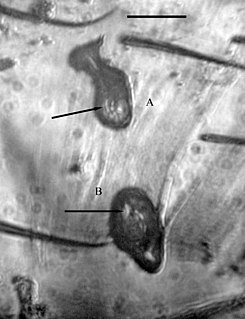Related Research Articles

Eimeria is a genus of apicomplexan parasites that includes various species capable of causing the disease coccidiosis in animals such as cattle, poultry, dogs, cats, and smaller ruminants including sheep and goats. Eimeria species are considered to be monoxenous because the life cycle is completed within a single host, and stenoxenous because they tend to be host specific, although a number of exceptions have been identified. Species of this genus infect a wide variety of hosts. Thirty-one species are known to occur in bats (Chiroptera), two in turtles, and 130 named species infect fish. Two species infect seals. Five species infect llamas and alpacas: E. alpacae, E. ivitaensis, E. lamae, E. macusaniensis, and E. punonensis. A number of species infect rodents, including E. couesii, E. kinsellai, E. palustris, E. ojastii and E. oryzomysi. Others infect poultry, rabbits and cattle. For full species list, see below.

Sarcocystis is a genus of protozoan parasites, the majority of species infecting mammals, and some infecting reptiles and birds.
Karyolysus is a genus of coccidia. With the exception of K. sonomae whose vertebrate host is the yellow-legged frog, species in this genus only infect lizards of the genus Lacerta.
The genus Polychromophilus consists of obligate intracellular eukaryotic parasites that infect bats from every continent except Antarctica. They are transmitted by bat flies, which act as an insect vector as well as the parasite’s site of sporogeny. Polychromophilus follows a fairly typical Haemospororidian lifecycle, with gametocytes and gametes restricted to the bloodstream of the host and meronts infecting organs – most notably the lungs and the liver. The type species is Polychromophilus melanipherus, and was described by Dionisi in 1898.
Dactylosoma is a genus of parasitic alveolates of the phylum Apicomplexia.

Hemolivia is a genus of the phylum Apicomplexia.

Vetufebrus is an extinct genus of haemospororida in the family Plasmodiidae. At the time of its description the new genus comprised a single species Vetufebrus ovatus known from a single Miocene Dominican amber fossil found on Hispaniola. V. ovatus was vectored by Enischnomyia stegosoma, the first fossil steblid bat fly described from a fossil, and the only member of the subfamily Nycterophiliinae described from Hispaniola. V. ovatus is the first instance of a Streblidae bat fly as a host for a malarial parasite.
Legerella is a genus of parasitic alveolates of the phylum Apicomplexa. Species in this genus that usually infect the malpighian tubules of invertebrates.

Klossiella is a genus of parasitic alveolates of the phylum Apicomplexa. Species in this genus infect the renal tract of mammals and intestinal tract of snakes.
Hyaloklossia is a genus of parasitic alveolates in the phylum Apicomplexa. Only one species in this genus is currently recognised - Hyaloklossia lieberkuehni.
Pseudoklossia is a genus in the phylum Apicomplexa. Species in this genus infect marine molluscs, although one species infects in an ascidian worm. The life cycle is heteroxenous.
The Caulleryellidae are a family of parasites in the phylum Apicomplexa. Species in this family mostly infect dipteran larvae.
The Schizocystidae are a family of parasitic alveolates in the phylum Apicomplexa. Species in this family infect insects.
Farinocystis is a genus of parasitic alveolates of the phylum Apicomplexa. Species in this genus infect insects (Coleoptera).
Mattesia is a genus of parasitic alveolates of the phylum Apicomplexa. Species in this genus infect insects.
Selenidium is a genus of parasitic alveolates in the phylum Apicomplexa. Species in this genus infect marine invertebrates.
Syncystis is a genus of parasitic alveolates in the phylum Apicomplexa.
Schizocystidae is a genus of parasitic alveolates in the phylum Apicomplexa.
Lipotropha is a genus of parasitic alveolates of the phylum Apicomplexa.
Lipocystis is a genus of parasitic alveolates of the phylum Apicomplexa.
References
- ↑ Bogoyavlensky N (1922) Menzbieria hydrachnae n. g., n. sp. Archives de la Societe Russe de Protistologie 1: 10-21
| | This Apicomplexa-related article is a stub. You can help Wikipedia by expanding it. |